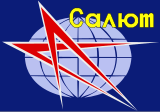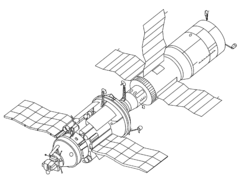Salyut 7

Salyut 7 photographed following the undocking of Soyuz T-13, 25 September 1985
|
|

The insignia of the Salyut Program
|
|
| Station statistics | |
|---|---|
| Crew | 3 |
| Launch | 19 April 1982 19:45:00 UTC |
| Launch pad | LC-200/40, Baikonur Cosmodrome, Soviet Union |
| Reentry | 7 February 1991 |
| Mass | 19,824 kg |
| Length | 16 m (minimum) |
| Width | 4.15 m (max. |
| Pressurised volume | 90 m³ (minimum) |
| Perigee | 219 km (118.25 nmi) |
| Apogee | 278 km (150.1 nmi) |
| Orbital inclination | 51.6 degrees |
| Orbital period | 89.2 minutes |
| Days in orbit | 3216 days |
| Days occupied | 816 days |
| Number of orbits | 51,917 |
| Distance travelled | 2,106,297,129 km (1,137,309,460 nmi) |
| Statistics as of de-orbit and reentry | |
| Configuration | |

Salyut 7 with docked Kosmos 1686 TKS spacecraft
|
|
Salyut 7 (Russian: Салют-7; English: Salute 7) (a.k.a. DOS-6) was a space station in low Earth orbit from April 1982 to February 1991. It was first manned in May 1982 with two crew via Soyuz T-5, and last visited in June 1986, by Soyuz T-15. Various crew and modules were used over its lifetime, including a total of 12 manned and 15 unmanned launches. Supporting spacecraft included the Soyuz T, Progress, and TKS spacecraft.
It was part of the Soviet Salyut programme, and launched on 19 April 1982 on a Proton rocket from Site 200/40 at the Baikonur Cosmodrome in what was then the Soviet Union. Salyut 7 was part of the transition from "monolithic" to "modular" space stations, acting as a testbed for docking of additional modules and expanded station operations. It was the tenth space station of any kind launched. Salyut 7 was the last Space Station of the Salyut Program, which was replaced by Mir.
Salyut 7 was the back-up vehicle for Salyut 6 and very similar in equipment and capabilities. With delays to the Mir programme it was decided to launch the back-up vehicle as Salyut 7. In orbit the station suffered technical failures though it benefited from the improved payload capacity of the visiting Progress and Soyuz craft and the experience of its crews who improvised many solutions (such as a fuel line rupture in September 1983 requiring EVAs by the Soyuz T-10 to repair). It was aloft for eight years and ten months (a record not broken until Mir), during which time it was visited by 10 crews constituting six main expeditions and four secondary flights (including French and Indian cosmonauts). The station also saw two flights of Svetlana Savitskaya making her the second woman in space since 1963 and the first to perform an EVA during which she conducted metal cutting and welding alongside her colleague Vladimir Dzhanibekov. Aside from the many experiments and observations made on Salyut 7, the station also tested the docking and use of large modules with an orbiting space station. The modules were called "Heavy Kosmos modules" though in reality were variants of the TKS spacecraft intended for the cancelled Almaz military space station. They helped engineers develop technology necessary to build Mir.
...
Wikipedia
